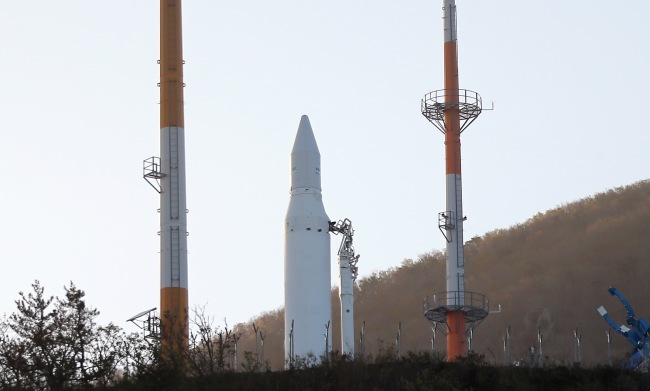 |
The Korea Space Launch Vehicle stands on its launch pad at Naro Space Center, Goheung, South Jeolla Province, Thursday, after authorities cancelled the launch, citing technical problems. (Photo pool) |
Korea called off the launch of its first space rocket again on Thursday due to a technical glitch on its electronic systems.
Officials of the Ministry of Education, Science and Technology and the Korea Aerospace Research Institute said that they detected malfunctions in the control system for a hydraulic pump that provides the thrust to the second-stage solid rocket.
“We will further look for and resolve the problem, and announce a new launch date in the near future,” Education, Science and Technology Minister Lee Ju-ho told reporters.
“We are sorry, and hope that the people will continue to support (the launch of the Naro),” Lee added.
The Korea Space Launch Vehicle-1, or the Naro rocket, was initially set to fire off into space at 4 p.m. The launch was canceled altogether at 4:08 p.m. after the countdown was halted less than 17 minutes before the scheduled takeoff.
This is the second time the ministry and KARI have canceled the liftoff, after the attempt was marred in October by a damaged seal in the connector between the first-stage rocket and the launch pad.
KARI officials said that they would have to examine the second-stage rocket early next week and replace components for the thrust vector control system, given that it takes some time to transport the rocket from the launch pad to its assembly house and disassemble it.
They did not give an estimated date for its next launch attempt.
Experts say that Korea may likely delay the launch to April next year since it will have to inform international organizations again to secure possible liftoff dates.
Russia made the first-stage liquid-engine rocket, while Korea made the second-stage solid-fuel rocket with its fairing including a Korean science satellite payload. Russia also provided its expertise in launch pad design and operations.
Korea has invested over 520 billion won ($479 million) in the development of the rocket.
Korea began the Naro space program in 2002, and Russia agreed to supply up to three rockets should Korea fail in the first two launches.
In 2009, Korea failed in its first attempt to send its satellite into orbit due to a fairing malfunction after the launch.
The country retried in 2010, but failed again as the rocket blew up shortly after liftoff, for which scientists could not find the reasons.
KARI and the Ministry of Education, Science and Technology initially planned to launch its third Naro last month, but called off the launch after discovering damage in the rocket’s helium supply system and rubber components.
This pushed Korean and Russian researchers back to the drawing board to investigate the flaw in the helium adaptor and rubber rings.
The ministry pushed back the new liftoff date for the third Naro to between Nov. 9 and 24. But the belated arrival of new Russian rocket components further delayed the launch, with officials saying it “would not hurry, but maintain precision for one last successful launch.”
Korea is preparing to develop its next domestically made three-stage liquid-fueled rocket weighing 200 tons and standing 46.5 meters high.
The country has allocated more than 1.5 trillion won to build the KSLV-2 by 2021, and aims to put a 1.5-ton application satellite into orbit for scientific research.
By Park Hyong-ki (
hkp@heraldcorp.com)



![[Herald Interview] 'Korea, don't repeat Hong Kong's mistakes on foreign caregivers'](http://res.heraldm.com/phpwas/restmb_idxmake.php?idx=644&simg=/content/image/2024/11/13/20241113050481_0.jpg)
![[KH Explains] Why Yoon golfing is so controversial](http://res.heraldm.com/phpwas/restmb_idxmake.php?idx=644&simg=/content/image/2024/11/13/20241113050608_0.jpg)



